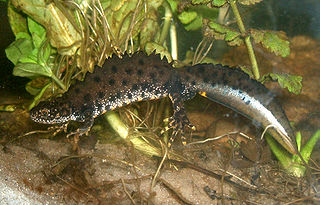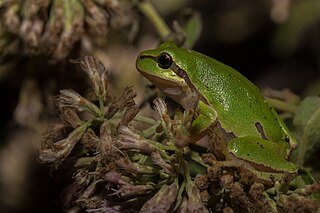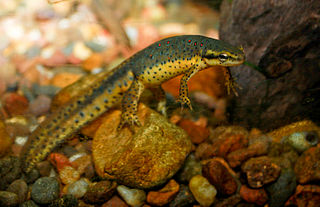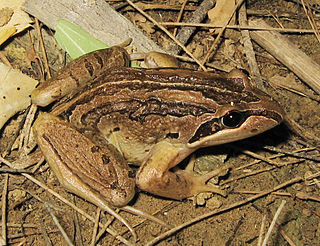
The smooth newt, European newt, northern smooth newt or common newt is a species of newt. It is widespread in Europe and parts of Asia, and has been introduced into Australia. Individuals are brown with a spotted underside that ranges in colour from orange to white. They reach an average length of 8–11 cm (3.1–4.3 in); males are larger than females. The newts' skins are dry and velvety when they are living on land, but become smooth when they migrate into the water to breed. Males develop a more vivid colour pattern and a conspicuous skin seam (crest) on their back when breeding.

The palmate newt is a species of newt found in Western Europe, from Great Britain to the northern Iberian peninsula. It is 5–9.5 cm (2.0–3.7 in) long and olive or brown with some dark spots. The underside is yellow to orange, and the throat, unlike in the similar smooth newt, always unspotted. A dark stripe runs along the head and through the eyes. Breeding males develop a distinct filament on the end of their tail, strongly webbed hind feet, and a low, smooth crest on their back.

The northern crested newt, great crested newt or warty newt is a newt species native to Great Britain, northern and central continental Europe and parts of Western Siberia. It is a large newt, with females growing up to 16 cm (6.3 in) long. Its back and sides are dark brown, while the belly is yellow to orange with dark blotches. Males develop a conspicuous jagged crest on their back and tail during the breeding season.

The sword-tail newt, sword-tailed newt, yellow-bellied newt, or Okinawa newt is a species of true salamander from the Ryukyu Archipelago in Japan.

The European tree frog is a small tree frog. As traditionally defined, it was found throughout much of Europe, Asia and northern Africa, but based on molecular genetic and other data several populations formerly included in it are now recognized as separate species, limiting the true European tree frog to Europe from France to Poland and Greece.

The eastern newt is a common newt of eastern North America. It frequents small lakes, ponds, and streams or nearby wet forests. The eastern newt produces tetrodotoxin, which makes the species unpalatable to predatory fish and crayfish. It has a lifespan of 12 to 15 years in the wild, and it may grow to 5 in (13 cm) in length. These animals are common aquarium pets, being either collected from the wild or sold commercially. The striking bright orange juvenile stage, which is land-dwelling, is known as a red eft. Some sources blend the general name of the species and that of the red-spotted newt subspecies into the eastern red-spotted newt.

Triturus is a genus of newts comprising the crested and the marbled newts, which are found from Great Britain through most of continental Europe to westernmost Siberia, Anatolia, and the Caspian Sea region. Their English names refer to their appearance: marbled newts have a green–black colour pattern, while the males of crested newts, which are dark brown with a yellow or orange underside, develop a conspicuous jagged seam on their back and tail during their breeding phase.

The striped marsh frog or brown-striped frog is a predominantly aquatic frog native to coastal Eastern Australia. It is a common species in urban habitats.

Notophthalmus meridionalis, the black-spotted newt or Texas newt, is a species of aquatic newt native to northeastern Mexico and southern Texas in the United States. This amphibian was put on the IUCN Red List of Endangered Species in 2008 with populations still decreasing. It was reclassified to Vulnerable in 2022.

The small-mouth salamander is a species of mole salamander found in the central United States, from the Great Lakes region in Michigan to Nebraska, south to Texas, and east to Tennessee, with a population in Canada, in Pelee, Ontario. It is sometimes referred to as the Texas salamander, porphyry salamander, or the narrow-mouthed salamander. The Kelley's Island salamander was synonymized with A. texanum in 1995.

The northern red-legged frog is a species of amphibian whose range is the coastal region stretching from southwest British Columbia to southern Mendocino County in Northern California, and is protected in Oregon and California. As a member of the genus Rana, this species is considered a true frog, with characteristic smooth skin and a narrow waist. This frog requires still waters for breeding, and is rarely found at any great distance from its breeding ponds or marshes.

Anderson's crocodile newt, Anderson's newt, Ryukyu spiny newt, or Japanese warty newt is a species of salamander in the family Salamandridae found in the Ryukyu Islands of Japan, and, at least formerly, Mount Guanyin in northern Taiwan, where it is now believed to be extinct.

The Danube crested newt or Danube newt is a species of newt found in central and eastern Europe, along the basin of the Danube river and some of its tributaries and in the Dnieper delta. It has a smaller and more slender body than the other crested newts in genus Triturus but like these, males develop a conspicuous jagged seam on back and tail during breeding season.

The Carpathian newt, or Montandon’s newt, is a species of salamander in the family Salamandridae found in Czech Republic, Poland, Romania, Slovakia, and Ukraine.

The southern marbled newt or pygmy marbled newt is a species of salamander in the family Salamandridae. It is found in Portugal and Spain. Its natural habitats are temperate forests, Mediterranean-type shrubby vegetation, rivers, intermittent rivers, freshwater marshes, intermittent freshwater marshes, arable land, pastureland, rural gardens, water storage areas, ponds, open excavations, irrigated land, canals and ditches. It is threatened by habitat loss.

The Cape mountain toad or Rose's mountain toad is a species of toad in the family Bufonidae. Other common names include Rose's mountain toadlet, striped mountain toad, Rose's toad, and Muizenberg Cape toad. It is endemic to South Africa, where its natural habitat is Mediterranean-type shrubby vegetation known as fynbos. It is threatened by habitat loss.
The Hispaniolan yellow tree frog, or common treefrog, is a species of frog in the family Hylidae endemic to Hispaniola, where it is found in both the Dominican Republic and Haiti.

Delalande's sand frog, also known as Delalande's frog, Cape sand frog, or striped pixie, is a species of frog in the family Pyxicephalidae. It is endemic to western and southern South Africa and occurs in the low-lying areas of Namaqualand, Western Cape, and Eastern Cape as far east as Cape St. Francis.

A newt is a salamander in the subfamily Pleurodelinae. The terrestrial juvenile phase is called an eft. Unlike other members of the family Salamandridae, newts are semiaquatic, alternating between aquatic and terrestrial habitats. Not all aquatic salamanders are considered newts, however. More than 100 known species of newts are found in North America, Europe, North Africa and Asia. Newts metamorphose through three distinct developmental life stages: aquatic larva, terrestrial juvenile (eft), and adult. Adult newts have lizard-like bodies and return to the water every year to breed, otherwise living in humid, cover-rich land habitats.

Ommatotriton ophryticus, the northern banded newt, is a species of newt in the family Salamandridae. It is found in northeastern Turkey and western Caucasus in Georgia, Armenia, and southern Russia.





















